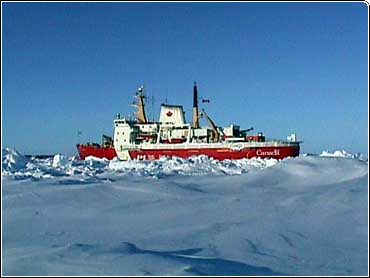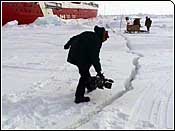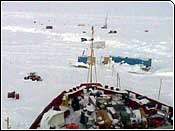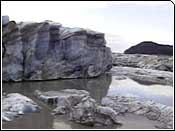|
| |
| Changes In The Air |
| |
Scientists Look At Climactic Shifts From One Of The Coldest Places On EarthCBS News Correspondent Jerry Bowen Reports |
| |
 |
|
| |
| This icebreaker has been frozen in the Arctic since October. |
| |
|
| |
ICE STATION SHEBA, Arctic Ocean
Thursday, May 28,1998 - 09:20 AM ET |
| |
(CBS) Three hundred miles off Alaska's north coast, ice station SHEBA is only a dot on the vast arctic horizon, a lone icebreaker and a hamlet of research huts drifting with the polar ice pack in search of clues to global warming.
SHEBA is a combination scientific outpost and armed camp. The only way in is by supply plane, and that's only possible if the runway hasn't cracked open.

(CBS) |
It's a place beyond civilization's reach, where a meandering polar bear is rare but not uncommon. Researchers carry guns just in case.
"If you hear five blasts, that means a polar bear has been sighted. If you hear seven blasts, that means there's some sort of problem on the ship. On the bright side, if you hear one blast, that means it's meal time," says chief scientist Don Perovich.
Researchers here work in 15-degree-below-zero weather, trying to gain a better understanding of our environment.

The desolate view from the icebreaker's bridge.(CBS) |
It's from the bridge of the Canadian icebreaker, where the engines have been at full stop since the ship deliberately rammed into position last October, that the ice camp comes into full view. It's an eerily desolate landscape where blowing ice-crystals look like desert sand, and instruments measuring sunlight look like something Martians have left behind to study us.
But SHEBA (Surface Heat Budget of the Arctic Ocean) is a study of what we may be doing to ourselves and to the Earth's atmosphere. It's a $20-million investigation, funded largely by the National Science Foundation.

December 1997:(CBS) |
Even the arctic clouds are being probed by plane and ground-based radar to determine their role in climate change here
the warmer climate that many scientists see as indication of global warming.
"Our focus here is to really pin down how the Arctic is going to play a role in this future climate," says the project's director, Dick Moritz.
And the early findings have caught researchers by surprise.
"The scenarios that are projected by most of the global models indicate thinning of the pack ice, a freshening of the upper Arctic Ocean, and a warming of the upper Arctic Ocean," Moritz says. "We found those three things, somewhat to our surprise, when we came in here last fall."
Even before the icebreaker arrived here to be frozen in for the long experiment, scientists found conditions in the Arctic were far from normal. Where they should have encountered the ice edge, they found only open water
100 miles more of it than expected. And when they reached the ice pack, it was just seven feet thick, not the expected 10 feet.
Is global warming to blame?
"We can say that we had a warm summer last year," Perovich says. "The ice was thinner. Whether or not that's part of a trend, we don t have enough base-line data."
| | | Reported by CBS News Correspondent Jerry Bowen
Copyright 1998, CBS Worldwide Inc., All Rights Reserved. |
|
|
|